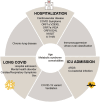Prediction models for COVID-19 disease outcomes
- PMID: 38828796
- PMCID: PMC11182058
- DOI: 10.1080/22221751.2024.2361791
Prediction models for COVID-19 disease outcomes
Abstract
SARS-CoV-2 has caused over 6.9 million deaths and continues to produce lasting health consequences. COVID-19 manifests broadly from no symptoms to death. In a retrospective cross-sectional study, we developed personalized risk assessment models that predict clinical outcomes for individuals with COVID-19 and inform targeted interventions. We sequenced viruses from SARS-CoV-2-positive nasopharyngeal swab samples between July 2020 and July 2022 from 4450 individuals in Missouri and retrieved associated disease courses, clinical history, and urban-rural classification. We integrated this data to develop machine learning-based predictive models to predict hospitalization, ICU admission, and long COVID.The mean age was 38.3 years (standard deviation = 21.4) with 55.2% (N = 2453) females and 44.8% (N = 1994) males (not reported, N = 4). Our analyses revealed a comprehensive set of predictors for each outcome, encompassing human, environment, and virus genome-wide genetic markers. Immunosuppression, cardiovascular disease, older age, cardiac, gastrointestinal, and constitutional symptoms, rural residence, and specific amino acid substitutions were associated with hospitalization. ICU admission was associated with acute respiratory distress syndrome, ventilation, bacterial co-infection, rural residence, and non-wild type SARS-CoV-2 variants. Finally, long COVID was associated with hospital admission, ventilation, and female sex.Overall, we developed risk assessment models that offer the capability to identify patients with COVID-19 necessitating enhanced monitoring or early interventions. Of importance, we demonstrate the value of including key elements of virus, host, and environmental factors to predict patient outcomes, serving as a valuable platform in the field of personalized medicine with the potential for adaptation to other infectious diseases.
Keywords: COVID-19 prediction; Long COVID; disease outcome prediction; machine learning; personalized medicine; predictive model for COVID-19.
Conflict of interest statement
No potential conflict of interest was reported by the authors.
Figures




References
-
- WHO Coronavirus (COVID-19) Dashboard . Updated June 28, 2023. [accessed July 4, 2023]. https://covid19.who.int/.
-
- COVID Data Tracker . Updated June 24, 2023. [accessed 2023 July 4]. https://covid.cdc.gov/covid-data-tracker/#datatracker-home.
-
- Long COVID . Updated May 17, 2023. [accessed 2023 July 4]. https://www.cdc.gov/nchs/covid19/pulse/long-covid.htm.
MeSH terms
Grants and funding
LinkOut - more resources
Full Text Sources
Other Literature Sources
Medical
Miscellaneous
